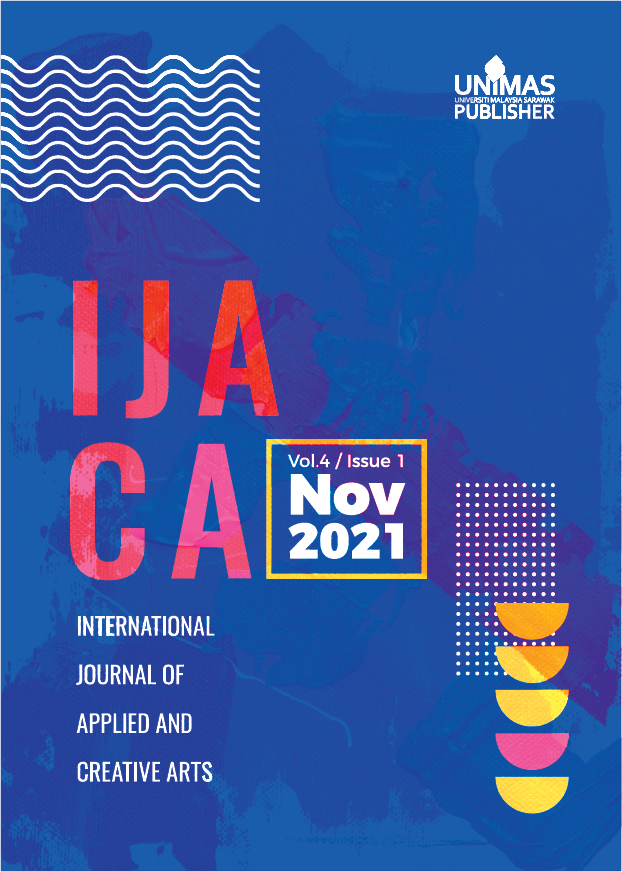THE DOCUMENTATION OF SELAYAH KERINGKAM EMBROIDERY PROCESS IN SARAWAK
DOI:
https://doi.org/10.33736/ijaca.3403.2021Keywords:
Selayah Keringkam Sarawak, Process, EmbroideryAbstract
This study aims to investigate the
process of Selayah Keringkam embroidery in
Sarawak as well as understanding the intricacy of
art and expertise in producing the Keringkam
embroidery that is now becoming the status of
Malay women in Sarawak. This study was
conducted to examine several types and
processing stages of Selayah Keringkam, thus, to
understand expertise in producing Selayah
Keringkam embroidery in more depth in order to
maintain the uniqueness of Keringkam art for the
people of Sarawak. The study involved Malay
women in Sarawak who have experiences in
processing and styling Keringkam. The
information obtained in order to meet the
objectives of this study was taken from websites
and journals that have been published and studied
further through research methodology and
previous studies. Research data were analyzed
and displayed quantitatively and qualitatively.
From the findings of this study, there are various
Selayah Keringkam embroidery processes that
have been researched and recorded in archives,
journals and articles related to Keringkam.
References
Amri, N. H. Z., Haron, H., & Samian, A. L. (2018a). The art of kelingkan embroidary as a catalyst for the development of creative industry. International Journal of Civil Engineering and Technology, 9(5), 25-30.
Amri, N. H. Z., Haron, H., & Samian, A. L. (2018b). Application of the kelingkan embroidery process in Malaysia. International Journal of Mechanical Engineering and Technology, 9(5), 524-530.
Amri, N. H. Z., Haron, H., Mutalib, N. A., & Hamdzun, S. N. H. (2019). Reinventing tradition through kelingkan embroidery handicraft in Malaysia. International Journal Mechanical Engineering and Technology, 10(09), 128-133.
Aty, Y. (n.d). Metode Dokumentasi. Retrieved from https://www.poltekkeskupang.ac.id/informasi/download/category/8- mkjk.html?download=33:doku
Awang, M. N. (n.d). Bab 8 Pendokumentasian. Retrieved from http://anyflip.com/xdwde/lmku/basic
Galeri Songket dan Keringkam (2020). Keringkam. Kuching, M.Y.
Hartono, F. (n.d). Bab iii PEMBAHASAN. 3.1 Pengertian Proses. Retrieved from https://docplayer.info/88189753-Bab-iii-pembahasan-3-1-pengertian-proses.html
Herlindah, I., Ningsih, T. Y., & Prayetno, D. (2019). Sistem Teknik Dokumentasi. Retrieved from https://www.researchgate.net/publication/332719197_SISTEM_TEKNIK_DOKUMEN TASI
Ibrahim Z (2020). Melestari Seni Sulaman Keringkam. Retrieved from https://www.kosmo.com.my/2020/12/15/melestari-seni-sulaman-keringkam/
Josmani, D. S. A., Kibat, S. A., Halamy, S., & Chan, V. S. L. (2012). Selayah keringkam, the traditional embroidery of the Sarawak malays. PSU - USM International Conference on Art and Sciences, 554-562
Mohajan, H. K. (2018). Aspects of Mathematical Economics, Social Choice and Game Theory. Dicapai dari https://www.researchgate.net/publication/321964409_Research_Methodology
Norseha, U. (2012). The Keringkam Veil of Sarawak. Retrieved from https://www.researchgate.net/publication/331382303_The_Keringkam_Veil_of_Sarawak
Othman, R. (2019). Contoh Metodologi Kajian. Retrieved from https://www.coursehero.com/file/45608831/CONTOH-METODOLOGI-KAJIANdocx/
Rusnan M. (2018), Memartabatkan seni warisan songket dan keringkam Sarawak. Retrieved from https://www.utusanborneo.com.my/2018/10/27/memartabatkan-seni- warisan-songket-dan-keringkam-sarawak
Rusyaidi, M. (2020). Keringkam's Starter Kits. Retrieved from https://issuu.com/st.contrast95/docs/keringkam_s_starter_kit_manual
Salem, K. (2012). The Sarawakiana Series - Culture & Heritage Sarawak Malay Culture: Tudung Keringkam. Retrieved from https://www.pustaka- sarawak.com/document_uploaded/1547616065.pdf
Sepini, A. R., Arif, A. H., & Abdullah, N. (2019). Motif & Design Patterns of Keringkam Embroidery for The Sarawak Malays. Retrieved from http://www.journal.pktm.org/index.php/ijtvet/article/download/8/6/
Sudarsono, B. (2017). Memahami Dokumentasi. Acarya Pustaka, 3(1), 46-65.
Downloads
Published
How to Cite
Issue
Section
License
Copyright Transfer Statement for Journal
1) In signing this statement, the author(s) grant UNIMAS Publisher an exclusive license to publish their original research papers. The author(s) also grant UNIMAS Publisher permission to reproduce, recreate, translate, extract or summarize, and to distribute and display in any forms, formats, and media. The author(s) can reuse their papers in their future printed work without first requiring permission from UNIMAS Publisher, provided that the author(s) acknowledge and reference publication in the Journal.
2) For open access articles, the author(s) agree that their articles published under UNIMAS Publisher are distributed under the terms of the CC-BY-NC-SA (Creative Commons Attribution-Non Commercial-Share Alike 4.0 International License) which permits unrestricted use, distribution, and reproduction in any medium, for non-commercial purposes, provided the original work of the author(s) is properly cited.
3) For subscription articles, the author(s) agree that UNIMAS Publisher holds copyright, or an exclusive license to publish. Readers or users may view, download, print, and copy the content, for academic purposes, subject to the following conditions of use: (a) any reuse of materials is subject to permission from UNIMAS Publisher; (b) archived materials may only be used for academic research; (c) archived materials may not be used for commercial purposes, which include but not limited to monetary compensation by means of sale, resale, license, transfer of copyright, loan, etc.; and (d) archived materials may not be re-published in any part, either in print or online.
4) The author(s) is/are responsible to ensure his or her or their submitted work is original and does not infringe any existing copyright, trademark, patent, statutory right, or propriety right of others. Corresponding author(s) has (have) obtained permission from all co-authors prior to submission to the journal. Upon submission of the manuscript, the author(s) agree that no similar work has been or will be submitted or published elsewhere in any language. If submitted manuscript includes materials from others, the authors have obtained the permission from the copyright owners.
5) In signing this statement, the author(s) declare(s) that the researches in which they have conducted are in compliance with the current laws of the respective country and UNIMAS Journal Publication Ethics Policy. Any experimentation or research involving human or the use of animal samples must obtain approval from Human or Animal Ethics Committee in their respective institutions. The author(s) agree and understand that UNIMAS Publisher is not responsible for any compensational claims or failure caused by the author(s) in fulfilling the above-mentioned requirements. The author(s) must accept the responsibility for releasing their materials upon request by Chief Editor or UNIMAS Publisher.
6) The author(s) should have participated sufficiently in the work and ensured the appropriateness of the content of the article. The author(s) should also agree that he or she has no commercial attachments (e.g. patent or license arrangement, equity interest, consultancies, etc.) that might pose any conflict of interest with the submitted manuscript. The author(s) also agree to make any relevant materials and data available upon request by the editor or UNIMAS Publisher.

